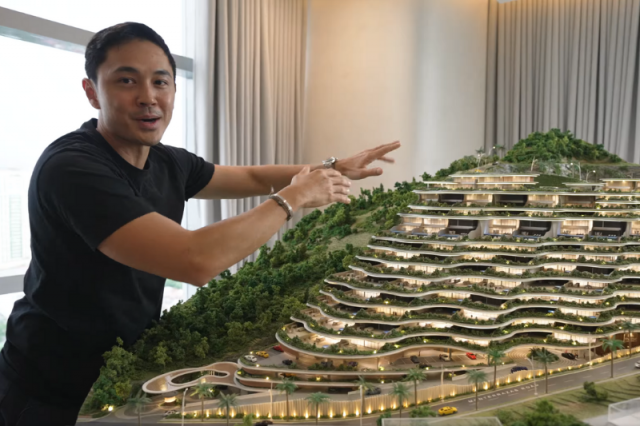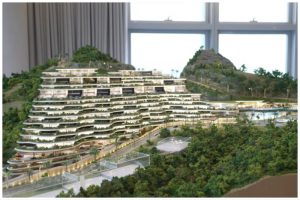
The viral real estate project of actor and civil engineer Slater Young may not be as sustainable as it is making itself appear to be, a wind engineer said.
Despite all the greenery present in the scale model, the building is susceptible to multiple hydrological and geological hazards such as floods, landslides and earthquakes.
On August 24, actor and civil engineer Slater Young unveiled the scale model of his real estate development, a project called The Rise at Monterrazas.
The project, inspired by the Banaue Rice Terraces, will be built on the mountainside in Guadalupe, Cebu.
Young added his team “wants the project to be as sustainable as possible.”
Instead of the common vertical design of condominiums, Young explained that they pushed the whole structure of the building towards the mountain, claiming it would lessen the project’s environmental impact—an architectural and engineering challenge that some online users were impressed with.
Others, however, criticized the project on social media, citing the irony of constructing a “sustainable” building after chipping away at a mountain for its construction.

Joshua Agar, a wind engineer and assistant professor at the UP Institute of Civil Engineering, saw this as a “disconnect” between projects designed for the wealthy and those meant for the common people.
Citing the World Sustainable Built Environment Conference in 2017, he said people behind real estate projects in countries such as Europe perceive sustainability and site considerations differently compared to those done in developing countries like the Philippines.
“The rich can look at their finished projects as dispensable if damaged to hazards, but the risk is not something that the common Filipino can afford,” he told Interaksyon in an interview.
Explaining the significant environmental concerns and shortcomings linked to the project, Agar said that the project’s current design may increase “topographic amplification.” This means forces such as the wind exerted on the building may increase fourfold compared to the effect on a conventional design.
The topographic amplification, Agar added, may also intensify ground shaking and may cause turbulence that will impact present structures. He also observed that the building will be facing towards the east, where most winds from previous typhoons come from.
Even if The Rise at Monterrazas condominium has a structure abiding by the conventional code-based design, Agar would not recommend it.
The main issue
The main shortcoming of the concept, Agar noted, is with how the forces applied to the building will be exerted back to the mountain, aligning with Newton’s third law of motion.
“The analysis only considered that the ground motion of the mountain due to an earthquake will transmit forces to the structure,” he said. “Since it is embedded on a mountain, this should require a soil-structure-soil interaction analysis, not a mere structural analysis.”
As the inertial force aggravates the stresses within the soil, the building could cross safety limits, especially when the building is anchored on the entire mountainside, Agar explained.
Besides the building’s structure and design, the wind engineer said the team should assess the effectiveness of its non-structural components such as cladding, glass walls and fixtures.
“Given that the building may experience stronger forces than the conventional design, you may expect glass breakage, debris and other projectiles to bring danger to the occupants,” he added.
What should be done
Agar made four suggestions to make the project more feasible:
- Limit the building footprint
- Construct the building vertically
- Conduct wind tunnel testing
- Apply the base isolation technique.
Limiting the building footprint would mean lessening the total land area covered by the building, emphasizing the need to reduce environmental disruption. Agar also mentioned that constructing the building on gentler slopes will minimize stability challenges compared to steeper ones.
“Before playing with the idea of having such a design, they should have tested it on a wind tunnel first,” he said.
Engineers employ wind tunnels to assess a building’s structural integrity, safety and functionality. In a wind tunnel test, a structure is subjected to simulated real-world wind conditions within a controlled environment to test if it is capable of withstanding strong, typhoons, and other environmental forces.
Recognizing the natural presence of environmental impacts in every project, Agar believes that these challenges should not deter engineers, architects and other professionals involved from striving for “the most optimal engineering design” in real estate projects. Projects, he said, should also aim for genuine sustainability.
“At the end of the day, engineers should not be mere builders, but they should be nation-builders,” he added.









